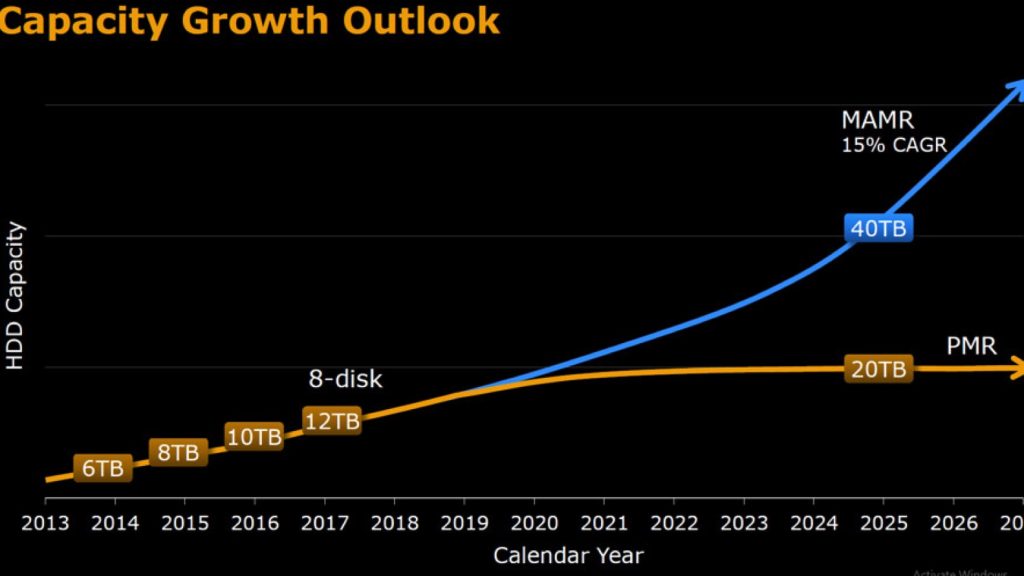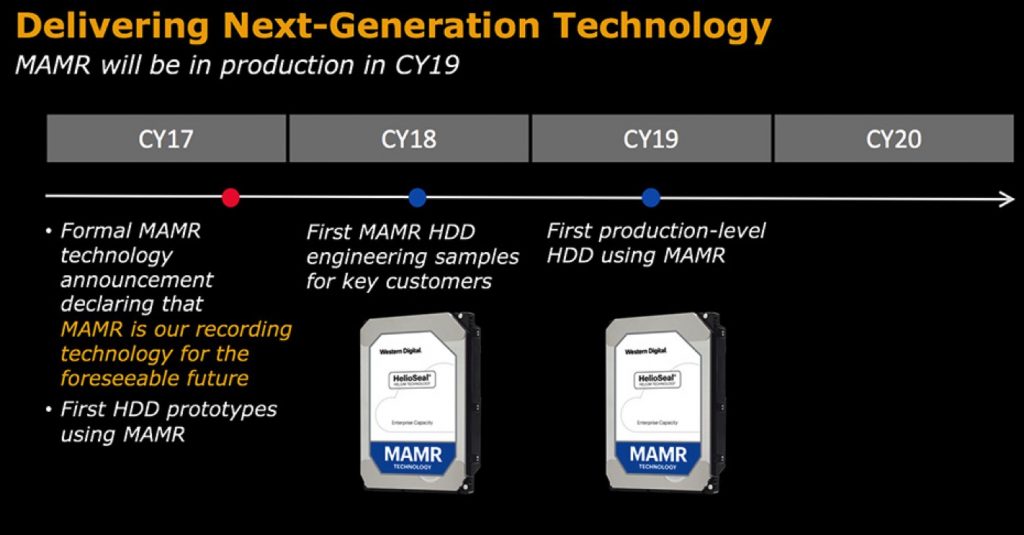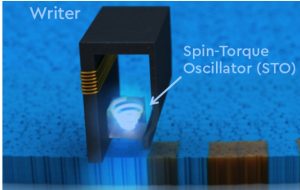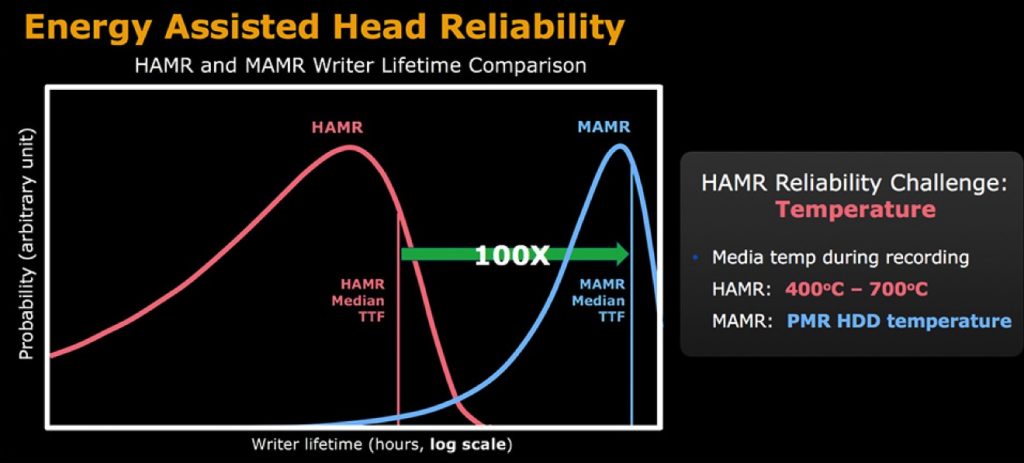MAMR by Western Digital: New Technology to Increase Capacity of HDD
To reach 16TB by 2019 and 40TB by 2025
This is a Press Release edited by StorageNewsletter.com on October 17, 2017 at 2:25 pmAt its Innovating to Fuel the next Decade of Big Data event Western Digital Corp. announced an innovation for delivering ultra-high capacity HDDs to meet the future demands of big data with proven data center-level reliability.
The event, held at the company’s HQs in Silicon Valley, included a demonstration of the world’s first microwave-assisted magnetic recording (MAMR) HDD and presentations from company executives and the inventor of MAMR technology, Professor Jimmy Zhu from Carnegie Mellon University.
The company also showcased advancements in micro actuation and Damascene recording head technology.
Western Digital expects to begin shipping MAMR HDDs in 2019 for use in data centers that support big data applications across a full range of industries.
“As the volume, velocity, variety, value and longevity of both big data and Fast Data grow, a new generation of storage technologies are needed to not only support ever-expanding capacities, but ultimately help our customers analyze and garner insights into our increasingly connected universe of data,” said Mike Cordano, president and COO, Western Digital. “Our ground-breaking advancement in MAMR technology will enable Western Digital to address the future of high capacity storage by redefining the density potential of HDDs and introduce a new class of highly reliable, ultra-high capacity drives. We have a proven track record for identifying, investing in and delivering advanced technologies that create new product categories and enable the world to realize the possibilities of data. Five years ago we introduced our HelioSeal, helium-filled drive technology. Since then, we have shipped more than 20 million helium drives. That type of leadership and innovation continues today and we aim to leverage it well into the future.”
MAMR is one of two energy-assisted technologies that Western Digital has been developing for years. The company recently innovated a breakthrough in material and process that provides the required reliable and predictable performance, as well as the manufacturability to accelerate areal density and cost improvements to an estimated average of 15% per year. Developments in the other energy-assisted technology, specifically, heat-assisted magnetic recording (HAMR), present new material science and reliability challenges that are not a factor in MAMR. Only MAMR demonstrates the reliability and cost profile that meets the demands of data center operators.
At the heart of the company’s innovation breakthrough is the spin torque oscillator used to generate a microwave field that increases the ability to record data at ultra-high density without sacrificing reliability.
MAMR technology is expected to offer over 4 terabits-per-square-inch over time. With sustained improvements in recording density, it promises to enable HDDs with 40TB of capacity and beyond by 2025, and continued expansion beyond that timeframe.
“Western Digital’s demonstration of MAMR technology is a significant breakthrough for the HDD drive industry,” said John Rydning, research VP, HDD drives, IDC. “Commercialization of MAMR technology will pave the way to higher recording densities, and lower cost per terabyte HDD drives for enterprise datacenters, video surveillance systems, and consumer NAS products.”
MAMR is builds upon a number of other innovations. In addition to HelioSeal helium-filled drive technology, MAMR also builds upon the company’s micro actuation and recording head manufacturing technologies. Western Digital’s micro actuation technology for data center applications enables HDDs to accurately and reliably position magnetic heads for writing and reading at ultra-high densities. The company’s head manufacturing operations are the only internal supplier to utilize Damascene processing to manufacture heads with the precise tolerances and complex structures required for reliable and cost-effective recording at ultra-high densities. The Damascene process also provides the capability to embed the spin torque oscillator that enables the manufacturing of MAMR heads. The combination of these technologies deliver superior TCO across all sizes of cloud and enterprise data centers.
The demonstration of Western Digital’s MAMR technology is the latest achievement in decades of HDD leadership from the company, including over 7,000 issued patents in HDD technology, on-going helium-enabled HDD technology advancements – as highlighted by the recent introduction of the world’s first host-managed shingled magnetic recording (SMR) technology enterprise 14TB HDD – and a long history of firsts in multi-disk design.
Comments
We discovered that the term of microwave assisted magnetic recording (MAMR) for the first time in a WD's patent application filed on December 21, 2012 ((9,355,654) for a "spin torque oscillator for microwave assisted magnetic recording with increased damping," the abstract being "A microwave assisted magnetic recording, (MAMR) write head includes a write pole tip, a trailing shield, and a spin torque oscillator between the write pole tip and the trailing shield. The spin torque oscillator may have a field generating layer and a damping layer which is exchanged coupled to the field generating layer." [See note below]
Today we need completely new technologies to increase the capacity of HDDs as PMR is reaching limits and to surpass helium-based technology introduced in 2013 by HGST.

Highest capacity drives culminate currently at 12TB and Western Digital/HGST just announced 14TB with SMR and helium sampling to OEMs. This time the company hopes to pack 16TB by 2019 and 40TB by 2025 with MAMR - not HAMR - and corresponding to a 15% CAGR.

There are two magnetic recording technologies being developed to provide the energy-assist, either heat-assisted or microwave-assisted.
HAMR
A technology that has been anticipated for the past 10- to 15-years HAMR, based on positioning a laser diode directly in front of the write head assembly, has engineering complexities and manufacturing challenges that need to be resolved. WD estimates that HAMR drives will not be commercially viable in the near term. It has chosen to introduce a solution supposed to be more cost-effective and more reliable, based on MAMR. Implementing a laser in every hard drive head assembly is expensive, driving up bill-of-materials cost. But the real concern is that when high heat is induced to a small, narrow area, it causes serious reliability issues. The high temperatures caused by laser heating also prevent use of the cost-effective aluminum disk material that is generally used in today's capacity enterprise hard drives, and instead, requires the use of more expensive glass substrates.
MAMR
MAMR required no laser and uses a microwave field generated from a spin torque oscillator (STO) that generates a microwave to provide assistance when magnetizing the grains prior to a write.

In this method, the STO, located near the write pole of the head, generates an alternating current (AC) field that allows data to be written to the perpendicular magnetic media at a lower magnetic field. The magnetic grains on disk are similar to spinning gyroscopes that are stable in either an up or down direction in the absence of an external field. When a sufficient magnetic field is applied in the opposite direction of the magnetic moment, the polarity flips in the direction of the applied field. Applying an additional gigahertz AC field from the STO can deliver that magnetic moment and flip the magnets more quickly, and at a lower magnetic field. The technical capabilities of the STO, coupled with the flexibility of the Damascene head-making process, enabled a complex head structure that embeds a tiny, yet effective STO, creating a breakthrough in head design while achieving capacity gains with reliability.
"Lifetime reliability tests show that the median time to failure of MAMR heads is one hundred times better than HAMR heads. Additionally, reliability tests over a population of heads show that the write lifetime hours demonstrated for 99.99% of MAMR heads is several orders better than the write lifetime hours for 99.99% of HAMR heads. Academic studies also show that MAMR also has the capability to extend areal density gains up to 4 terabits per square inch - SMR gains at 1300Gb/in2 - PMR gains at 1100Gb/in2," according to WD.
"MAMR has better reliability than HAMR. The temperature during write (Tc) is lower for MAMR. HAMR temperatures need to be above 650°C during write, while MAMR recording temperature is similar to PMR. The higher heat required for HAMR impacts reliability of the media, head and interface materials," the company added.
Heads produced using the Damascene process provide a track per inch advantage over the previously used dry pole process, delivering the high track density, with improved quality and higher head yields.
The amount of change required to make HAMR functional is higher than the degree of changes required by MAMR. This later uses the same media materials and similar head manufacturing process as PMR. HAMR requires a new substrate, new media materials, new head materials and a new manufacturing process.

Comparing MAMR vs. HAMR

Like for HAMR, WD didn't reveal other spec than capacity, nothing on access time, transfer rate and price to better judge if it has a chance to be successful.
Note:
Dr. Roy Cideciyan, IBM Research, Zurich, Switzerland, point out in an email following the publication of this article:
"Microwave Assisted Magnetic Recording was the title of a paper by Prof. Jimmy Zhu et al. in 2008. (Zhu Jian-Gang, et al. Microwave Assisted Magnetic Recording. IEEE Transactions on Magnetics. 2008, vol.44, p.125-131.). It was also the title of a presentation by Prof. Jimmy Zhu to IDEMA in 2007."














 Subscribe to our free daily newsletter
Subscribe to our free daily newsletter


